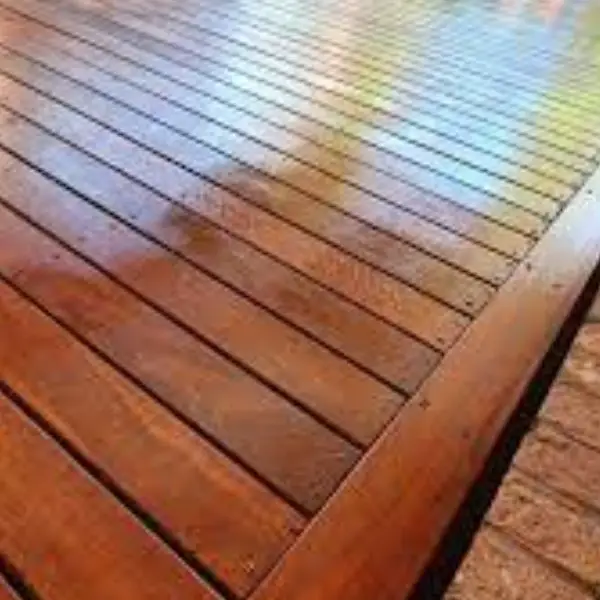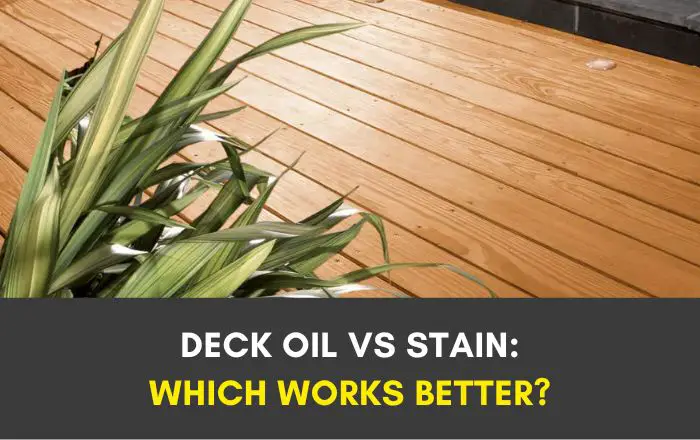Deck oils and deck stains are two different things used to treat decks. Deck oils are special oils that help protect your deck.
They keep it safe from water, sun damage, and tiny organisms that can harm it. Deck stains have color in them and can change the color of your deck. Using stain can make your deck last longer and you won’t have to replace it so soon.
Stain changes the color and look of the wood. When you put stain on different types of wood, it can look different.
Decking oil doesn’t change the wood’s color much; it just makes it look better while showing the natural wood pattern. Decking oil is better for keeping your deck safe and lasting longer, but using stain is a good way to change how your outdoor space looks.
What Is Deck Oil?
Decking oil is used to protect wood from water, damage, and sunlight. You can find it in clear or colored forms.
This oil helps replace the natural oils in wood that get lost over time, keeping the wood’s natural look. Darker oils protect better from sunlight than clear ones.
Unlike wood stains, decking oil doesn’t really change the color or look of the wood. Sometimes the wood might look a bit darker after you put the oil on.
Decking oil lets you see the natural pattern of the wood, unlike some stains or paints that sit on top of the wood.
You can get decking oil in two types: water-based or oil-based. If you use oil-based, you’ll need something like mineral spirits to clean up, not just soap and water like you would with water-based products.
Putting decking oil on your deck is pretty easy and helps stop the wood from warping, splitting, or cracking as it gets older.
Pros
- Deck oil covers a lot of area, sometimes up to 24 square meters per liter.
- It dries quickly, often in 4 to 8 hours for light walking.
- Many deck oils have UV filters to protect the wood from sun damage. Darker oils usually offer better protection.
- Helps maintain the wood’s natural oils, keeping it healthy.
- Protects the wood from warping, cracking, and splitting.
- Simple to apply, maintain, and clean. Doesn’t always need the wood to be completely stripped before reapplying.
- Easy to do small repairs in high-traffic areas.
- Doesn’t cause the wood to peel or flake.
- Helps prevent mold and algae if well-maintained.
- Less slick than stains, giving better grip.

Cons
- May not work well with some exotic hardwoods like Iroko or Teak.
- The original color of the wood can affect the final look.
- If you’ve used deck oil, you can’t cover it with stain or paint unless the wood is completely stripped or weathered for years.
What Is Deck Stain?
Deck stain is kind of like a paint for your deck. It acts like a shield, protecting the wood from sun, rain, and things like bacteria and algae. It’s like a barrier that stops these things from damaging the wood.
You can easily apply stain with a paintbrush and it comes in many different wood colors. Stain makes the deck look nicer and shows off the natural wood pattern. The main point of stain is to change the color of the wood.
Depending on the type of stain, you can still see all, some, or none of the wood grain.
Like decking oil, it’s good to check and maybe redo the stain every year, depending on how it holds up to the weather. You can buy two types of stains at stores: water-based and oil-based.
Water-based Stain
Water-based stains just sit on top of the wood and dry quickly. They’re easy to clean up with just soap and water.
Oil-based Stain
Oil-based stains go into the wood and let you see the wood grain. They’re easy to fix and redo as needed. But to clean this kind off your skin or tools, you need something like mineral oil or other chemicals.

Pros
- Creates a strong, protective layer on the wood.
- The pigments in the stain reduce sun damage, preventing fading.
- Works well on parts like railings and spindles.
- Offers solid coverage and vibrant color.
- Dries fast and is waterproof, allowing for use in hours.
- Hard for mold and algae to grow on stained surfaces.
Cons
- Can make the wood grain less noticeable.
- If moisture gets under, the wood can peel or flake.
- Tough to remove from grooved decking for reapplication.
- Not suitable for decks previously treated with oil.
- Must be completely removed for re-staining or if it starts to deteriorate.
- New, oily woods like Iroko or Cumaru might need time to weather before staining.
Deck Vs Oil Stain: Features Comparison
Long-Lasting
Deck oils need to be reapplied every 6-8 months, but they’re still good for making your deck last longer. Stains can last 1-2 years, so you don’t have to redo them as often. You’ll know it’s time to restain when the deck starts looking old or dirty.
Protection
Deck oils are great at keeping water out and protecting against sun damage. They also help stop mold and fungus. Stains change the wood’s color and can also protect against the sun. Both oil and stain-based versions are good at keeping the wood safe.
Pigmentation
Stains have more color choices, so you can change how your deck looks. Deck oils have some color too, but they won’t change the wood’s look as much as a stain.
Mold and Algae Protection
Deck oil fills small gaps in the wood, preventing algae and fungi. Stains create a protective layer on top, also blocking these growths. You might need to clean your deck before oiling it.
Working
There are two types of deck oils: water-based and oil-based. Both work by soaking into the wood. Stains are more like coatings that sit on top of the wood to protect it from things like sun and rain.
Traction
Deck oil is better for walking on because it keeps the wood’s natural texture, making it less slippery. Stains can make the surface more slippery since they add a layer on top.
Water Resistance
Deck oil is really good at keeping water out because it gets into the wood’s gaps. Stains just cover the surface, so they’re not as effective against water.
Usage Time
You’ll need to reapply deck oil every 8-19 months. For stains, clear ones might need redoing every year, but solid-colored ones can last up to five years. It depends on how the deck looks.
Fill Up With Natural Oil
If your deck is drying out or getting damaged, deck oil can help. It fills in cracks and gaps. Stains are mainly for color and don’t do this.
Simple to Use
Stains need you to remove old color first, but oils just need a dust clean-up. This makes oils easier to apply.
Deck Vs Oil Stain: Which Product Should be Used?
Decking oil is great for protecting the wood and keeping its original look. It soaks into the wood and helps to keep it strong and healthy. On the other hand, deck stain adds a layer of color on top of the wood.
It can hide the natural grain but gives you the option to pick different shades to match your style. Stain can also offer more protection against the sun and weather.
So, if you want to keep the wood’s natural beauty, go with oil. But if you want more color choices and extra protection, a stain might be better.
Final Thoughts
Choosing between deck oil and stain can be tricky, but it’s important for making your outdoor space look the way you want.
Deck oil sinks into the wood, keeping its natural color and look, while stain sits on top and changes the wood’s color. Both have their own good points.
In simple terms, if you like your wood’s natural color and want to keep it, go for oil. But if you want to change the color and make your deck look different, then use a stain. This choice is key to taking care of your deck and getting the look you want.
Hina Kanwal is the dynamic force behind Deckfaqs.com, blending her expertise in deck design with actionable insights. Known for her engaging content and practical advice, she empowers homeowners to elevate their outdoor spaces. Her passion and knowledge make her a trusted voice in the world of deck-building.







